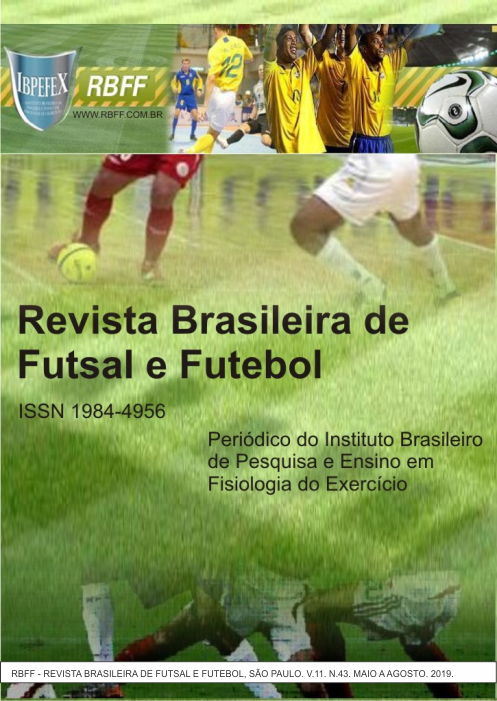Acceptance and overcoming of motor error by practitioners from UFPB female's futsal team
Abstract
The motor ability has to be well developed so the athletes can optimize their performance, so this cross-sectional case study of mixed nature, with transversal lineation presents a new method to improve the abilities of futsal. The objective is to analyze the efficiency of the method related to acceptance and overcoming of motor error (AOME) thru the female futsal team participates' perception. Thus, semi-structured interview was made and examined by the speech analysis of female futsal players (n= 3) from the Universidade Federal da Paraíba/UFPB's team, with the practitioners' characteristics identified by absolute frequency, mean and standard deviation. The AOME method was apply by Physical Education's students, using images, bidimensional taxonomy, applied in blocked condition and feedback. To select the participates and ability observations and video recording during usual training were done. The activities were practiced individually in two days per week, thirty minutes per day. The participates were dexterous, mean age was 21,6 years (±3,0), were classified into associative (n=2) and cognitive (n=1) stage of learning on ball controlling and kicking. The results showed that two players accepted their motor error quickly, meanwhile the other one needed more visual and verbal resources to visualize and accept her mistake. In conclusion, the AOME method was effective to promote the improvement on the motor skills researched, showing a valid contribution to the upgrade of futsal's motor performance.
References
-Aburachid, L. M. C.; e colaboradores. O nível de coordenação motora após um programa de treino em futsal. Revista Brasileira de Futsal e Futebol. Vol. 7. Num. 23. p. 25-34. 2015. Disponível em: <http://www.rbff.com.br/index.php/rbff/article/view/311/256>. Acesso em: 21/05/2018.
-Brandão, M.; e colaboradores. Uso de demonstração melhora a performance motora de meninos em habilidades do futsal. Revista Brasileira de Futsal e Futebol. Vol. 8. Num. 31. p. 334-339. 2016. Disponível em: <http://www.rbff.com.br/index.php/rbff/article/view/459/374>. Acesso em: 23/07/2018.
-CBFS, C. B. D. F. D. S. Livro Nacional de Regras, 2018. Disponível em: <http://www.cbfs.com.br/2015/futsal/regras/livro_nacional_de_regras_2018.pdf>. Acesso em: 12/08/2018.
-David, G. B.; Picanço, L. M.; Reichert, F. F. Análise de fatores determinantes do gol no futsal feminino. Revista Brasileira de Futsal e Futebol. Vol. 6. Num. 19. p. 18-26.2014. Disponível em: <http://www.rbff.com.br/index.php/rbff/article/view/225/208>. Acesso em: 03/06/2018.
-Filgueiras, L. F. A. S. Comparação entre a metodologia de abordagem sistêmica e a metodologia tecnicista: razões para promover o processo de ensino aprendizagem dos JECS através de jogos. Revista Brasileira de Futsal e Futebol. Vol. 6. Num. 22. p. 317-321. 2014. Disponível em: <http://www.rbff.com.br/index.php/rbff/article/view/230/252>. Acesso em: 07/10/2018.
-Fitts, P. M.; Posner, M. I. Human Performance: basics concepts in psychology series. Belmont.CA: Brooks/Cole Pub. Co. 1967.
-Gentile, A. M. Skill acquisition: action, movement and neuromotor process. In Carr, J.H.; Shepered, R.B.; Gordon, J.; Gentile, A.M.; Held, J.M.(Eds.), Movement Science: foundation for physical therapy in rehabilitation, p. 93-154. Rockville. MD. Aspen. 1987.
-Herzfeld, D. J.; e colaboradores. A memory of errors in sensorimotor learning. Science. Vol. 345. Num. 6202. p. 1349-1353. 2014. Disponível em: <http://science.sciencemag.org/content/345/6202/1349.full>. Acesso em: 29/09/2018.
-Katzer, J. I. Conhecimento de performance com base no Teste do Desempenho Motor do Nado Crawl, na aprendizagem do nado crawl. Revista Brasileira de Ciências do Esporte. Vol. 37. Num. 3. p. 245-250. 2015. Disponível em: <http://www.scielo.br/pdf/rbce/v37n3/0101-3289-rbce-37-03-0245.pdf>. Acesso em: 21/10/2018.
-Klüber-Ross, E. Sobre a morte e o morrer: o que os doentes têm para ensinar a médicos, enfermeiras, religiosos e aos seus próprios parentes. Tradução de Paulo Menezes. 7ª edição. São Paulo. Martins Fontes. 1996.
-Martins, C.O. Da escola ao alto rendimento: como facilitar o feedback adequado [no prelo]. Rio de Janeiro. Fundação Biblioteca Nacional.18p. 2018.
-Meugnot, A.; Toussaint, L. Functional plasticity of sensorimotor representations following short-term immobilization of the dominant versus non-dominant hands. Acta Psychologica. Num. 155. p. 51-56. 2015.
-Miguel, H. Treinamento tático no futsal. Londrina. Sport Training. Teoria e metodologia do treinamento desportivo. 2015.
-Orlandi, E. P. Discurso e texto: formulação e circulação dos sentidos. Campinas-SP. Pontes. 2001.
-Rodrigues, P. F. S. Processos cognitivos visuoespaciais e ambiente visual circundante: implicações educacionais. Psicologia: Teoria e Pesquisa. Vol. 32. Num. 4. p. 1-10. 2017.
-Samulski, D. Psicologia do esporte: conceitos e novas perspectivas. 2ª edição. Manole.2009.
-Schmidt, R. A.; Lee, T. D. Aprendizagem e performance motora: dos princípios à aplicação. Tradução Denise Costa Rodrigues. Revisão técnica Ricardo Petersen. 5ª edição. Porto Alegre.Artmed. 2016.
-Thomas, J. R.; Nelson, J. K.; Silverman, S. Métodos de pesquisa em educaçãofísica. Tradução de Denise Regina de Sales e Márcia dos Santos Dornelles. 5ª edição. Porto Alegre. Artmed. 2007.
-Tobias, W. O.; Cazella, R. D.; Ribeiro, D. A. Fatores relacionados à desistência da prática do futsal em crianças e adolescentes. Revista Brasileira de Futsal e Futebol. Vol. 8. Num. 29. p. 181-189. 2016. Disponível em: <http://www.rbff.com.br/index.php/rbff/article/view/411/351>. Acesso em: 08/09/2018.
-Voser, R. C. Futsal: princípios técnicos e táticos. 2ª edição.Canoas.ULBRA.2003.
-Waltrick, R. D.; Reis, M. A dos. Iniciação e formação de atletas em futsal -desenvolvimento técnico-tático e metodologias de ensino. Revista Brasileira de Futsal e Futebol. Vol. 8. Num. 31. p. 302-312. 2016. Disponível em: <http://www.rbff.com.br/index.php/rbff/article/view/345/369>. Acesso em: 25/09/2018.
Authors who publish in this journal agree to the following terms:
- Authors retain the copyright and grant the journal the right of first publication, with work simultaneously licensed under the Creative Commons Attribution License BY-NC which allows the sharing of the work with acknowledgment of the authorship of the work and initial publication in this journal.
- Authors are authorized to enter into additional contracts separately for non-exclusive distribution of the version of the work published in this journal (eg, publishing in institutional repository or book chapter), with acknowledgment of authorship and initial publication in this journal.
- Authors are allowed and encouraged to post and distribute their work online (eg, in institutional repositories or on their personal page) at any point before or during the editorial process, as this can bring about productive change as well as increase impact and impact. citation of published work (See The Effect of Free Access).





